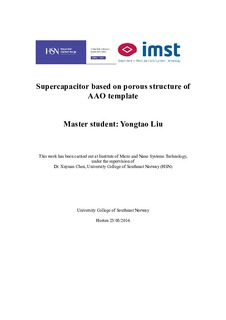| dc.description.abstract | As a kind of energy storage devices, supercapacitor has a broad application prospect in using renewable energy, powering electric vehicles, enabling portable equipment, and cordless powering internet of thing. This thesis report the research on the development of on-chip MEMS supercapacitors.
We focus on both electrostatic capacitor and electrochemical capacitors. We try to improve the energy density and power density of these capacitors by different methods.
A. Electrostatic supercapacitor. 1. In order to increase the effective area for increased capacitance, we use (anodic aluminum oxide (AAO) template as the scaffold for electrode of the capacitors, which has high pore density, thus the high specific area. Gold or copper was deposited as the electrical conducting layer. For the dielectric layer, we can deposit SiO2 or HfO2 by sputtering or atomic layer deposition (ALD technology). 2. To further improve energy density, a multilayer capacitor design has been proposed. The layers of the electrode and dielectric in sequence can fabricated on the AAO template by such as ALD or sputtering technology. Formed static capacitors in parallel connection will greatly increase the capacitance.
B. Electrochemical supercapacitor. Based on the AAO scaffold, we fabricated an electric double layer capacitor (EDLC) using gold layer as the active electrode layer. To improve the energy density of EDLC, unsymmetrical design consisting of EDLC electrode and pseudo electrode is investigated. MnO2 is employed as the pseudo material which we can load it on the AAO template by electrochemical plating method.
Profiler meter, probe station, and Zahner IM6 Electrochemical workstation were utilized to characterize the sample structure such as the thickness of the electrical conducting and dielectric layer, the conductivity of the conducting layer, and capacitors performance. According to the result, we have achieved the specific capacitance about 1-2uF/cm2 for electrostatic supercapacitor fabricated by sputtering process, which is smaller than the published results (about 10-100uF/cm2) from capacitors fabricated by ALD process. The specific capacitance of EDLC and pseudo supercapacitor with porous structure has an significant improvement compare with the flat one. We achieved the specific capacitance about 50-100mF/cm2 for pseudo supercapacitance. | nb_NO |
